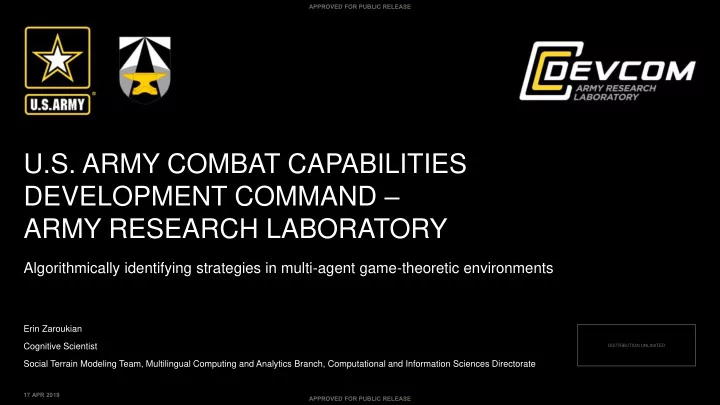

APPROVED FOR PUBLIC RELEASE U.S. ARMY COMBAT CAPABILITIES DEVELOPMENT COMMAND – ARMY RESEARCH LABORATORY Algorithmically identifying strategies in multi-agent game-theoretic environments Erin Zaroukian Cognitive Scientist DISTRIBUTION UNLIMITED Social Terrain Modeling Team, Multilingual Computing and Analytics Branch, Computational and Information Sciences Directorate 17 APR 2019 APPROVED FOR PUBLIC RELEASE
APPROVED FOR PUBLIC RELEASE INTRODUCTION • Computational agents should support their human teammates by adapting their behavior to the humans’ strategy for a given task in order to facilitate mutually-adaptive behavior within the team. • While there are situations where human strategies are top-down, explicit, and easy to understand, human strategies are often implicit and ad hoc . • Our goal: Identify and label the implicit human strategies Facilitate transparency, promote trust, and provide a better understanding of how humans work together and how computational teammates can be trained to fit into a human-human dynamic. 2 APPROVED FOR PUBLIC RELEASE
APPROVED FOR PUBLIC RELEASE STRATEGIES IN MOVEMENT DATA • Strategies aren’t observable! Infer through measurements of behaviors toward a goal. • Existing methods for identifying strategies often require: – Verbal reports of strategy – A priori set of strategies to recognize • e.g., RElative MOtion – A priori chunking / atomic units of movement data (usually in highly constrained environments) • e.g., Context Free Grammars, Linear Temporal Logic – Repetition • e.g., ALCAMP • We use timeseries techniques – Univariate measure of group configuration – polygon area – Identify strategies through Change Point Detection (CPD) and Dynamic Time Warping (DTW) 3 APPROVED FOR PUBLIC RELEASE
APPROVED FOR PUBLIC RELEASE METHOD – PREDATOR-PREY PURSUIT ENVIRONMENT 4 APPROVED FOR PUBLIC RELEASE
APPROVED FOR PUBLIC RELEASE METHOD – PREDATOR- PREY PURSUIT “STRATEGIES” Fixed policy Trained policy 5 APPROVED FOR PUBLIC RELEASE
APPROVED FOR PUBLIC RELEASE METHOD - TIMESERIES • Polygon area • Timeseries – Test episodes were creating by interleaving different strategies, i.e., ground truth segments fixed trained fixed trained trained fixed 6 APPROVED FOR PUBLIC RELEASE
APPROVED FOR PUBLIC RELEASE EXAMPLE – EPISODE 2 gif shown at SPIE: http://ezaroukian.github.io/CVmaterials/plotsCombo-interp-2.gif 7 APPROVED FOR PUBLIC RELEASE
APPROVED FOR PUBLIC RELEASE METHOD – STRATEGY IDENTIFICATION • Change Point Detection (CPD) – Combination of various cost functions (mean, variance, covariance, rank, density, etc.) from different distributions of data was utilized to determine change points in the timeseries • Divide data into CPD fragments , which can be compared to ground truth segments CPD-detected breakpoints CPD fragments • Dynamic Time Warping (DTW) – Compare similarities between pairs of timeseries (CPD fragments). DTW similarity scores Fragment 2 3 4 1 2 x 3 8 APPROVED FOR PUBLIC RELEASE
APPROVED FOR PUBLIC RELEASE RESULTS • CPD – Metrics comparing ground truth to CPD breakpoints Hausdorff Precision, Recall Rand index distance (/500) 20 timestep margin Episode 1 0.50, 1.0 0.97 235 (47%) Episode 2 0.67, 0.80 0.94 40 (8%) Episode 3 0.67, 0.67 0.95 20 (4%) Episode 4 0.85, 0.85 0.94 25 (5%) • DTW – Similarity scores between same-strategy CPD fragments (median = 0.96) > different-strategy CPD fragments (median = 0.90, Mann-Whitney U = 675, n = 58, p < 0.001, r = 0.55). 9 APPROVED FOR PUBLIC RELEASE
APPROVED FOR PUBLIC RELEASE DISCUSSION • Our goal: Identify and label the implicit human strategies Facilitate transparency, promote trust, and provide a better understanding of how humans work together and how computational teammates can be trained to fit into a human-human dynamic. – Using timeseries techniques, multi-agent predator-prey pursuit task and policy as ground truth • Represent group configuration as polygon area • Split with CPD • Classify with DTW Fragment 2 3 4 5 6 7 1 2 3 4 6 3 4 5 1 2 7 5 6 10 APPROVED FOR PUBLIC RELEASE
APPROVED FOR PUBLIC RELEASE DISCUSSION • Limitations – How well will this method work • When obstacles are introduced to the predator-prey environment? • When human teammates are introduced? – What information goes into the timeseries • Polygon area looses information, try dynamic factor analysis • May depend on strategies – CPD • Cost • Sampling rate / quantity of data – DTW • High similarity for different strategies! – If strategies are unobservable, how useful is comparison to “ground truth” (policies)? • Extensions – t-distributed stochastic neighbor embedding (TSNE) • How specific behaviors are linked to the activations of the network Do strategy/policy changes map to changes in NN activation? – Information Theoretic Disentanglement • Can strategy be disentangled via deep NN? 11 APPROVED FOR PUBLIC RELEASE
APPROVED FOR PUBLIC RELEASE THANK YOU • Thanks to Sebastian S. Rodriguez, Sean L. Barton, James A. Schaffer, Brandon Perelman, Nicholas R. Waytowich, Blaine Hoffman, Derrik E. Asher, and Jonathan Z. Bakdash 12 APPROVED FOR PUBLIC RELEASE
APPROVED FOR PUBLIC RELEASE 13 APPROVED FOR PUBLIC RELEASE
APPROVED FOR PUBLIC RELEASE DTW SIMILARITY SCORES Episode 1 Fragment 2 3 1 0.81 0.87 2 0.93 Episode 2 Fragment 2 3 4 5 6 7 1 0.93 0.97 0.86 0.96 0.98 0.95 2 0.86 0.92 0.91 0.90 0.97 3 0.79 0.94 0.99 0.87 4 0.86 0.84 0.93 5 0.97 0.92 6 0.91 Episode 3 Fragment 2 3 4 1 0.91 0.95 0.90 2 0.92 0.99 3 0.91 Episode 4 Fragment 2 3 4 5 6 7 8 1 0.82 0.97 0.88 0.97 0.89 0.98 0.95 2 0.76 0.92 0.82 0.93 0.81 0.88 3 0.82 0.98 0.79 0.98 0.91 4 0.89 0.97 0.86 0.95 5 0.82 0.98 0.94 6 0.83 0.93 7 0.96 14 APPROVED FOR PUBLIC RELEASE
Recommend
More recommend